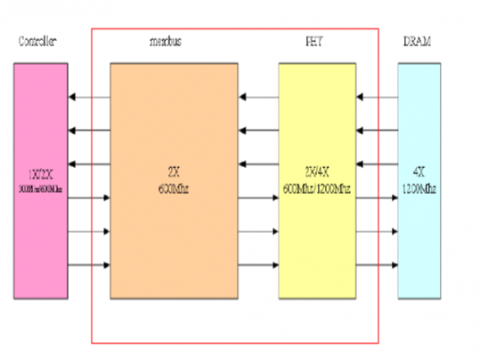Description
The DDR4/3 PHY is compatible with JEDEC DDR3 and JEDEC DDR4 SDRAMs, supports a range of DDR3 DRAM speeds from 666Mbps to 2133Mbps and DDR4 DRAM speeds from 1866Mbps to 2400Mbps, and target support x16 DDR3/DDR4 SDRAM components, the design include an analog hard macro (CLK/CMD/ADDR/DQ/DQS) and a synthesizable digital design. It supports software auto training includes read gate, read/write data eye timing, and PHY Vref settings. Supports DDR4/DDR3 SDRAM.
Optimized for high performance, low latency, low area, low power, and ease of integration, the DDR4/3 PHY is provided as a hard DDR PHY that is primarily delivered as GDSII including integrated application-specific DDR4/3 I/Os. Supporting the GDSII-based PHY is the RTL-based PHY. The DDR4/3 PHY includes a DFI 4.0 interface to the memory controller and can be combined with controllers for a complete DDR (Double Data Rate) interface solution

Features
-
Supports DDR4/DDR3 SDRAM
-
DDR4 JEDEC standard 1.2v I/O (POD_12 I/O)
-
DDR3 JEDEC standard 1.5v I/O (SSTL_15-compatible)
-
16 bits width, Single Channel DDR4/DDR3 SDRAM Interface.
-
16 bits for per channel, could support 2 x8 bits DDR3
-
Memory Clock up to 600MHz, DFI Clock up to 600MHz.
-
Support DDR3 800/1066/1333/1600/1866/2133Mbps; DDR4 1866/2133/2400Mbps
-
Supports DFI like interface
-
4-bit pre-fetch architecture
-
DLL Lock for 1200MHz
-
Supports SW DDR training
-
Supports DDR IO loopback test
-
Providing per bit de-skew function
-
Supports DDR3 DLL disable mode (CL6/CWL6)
-
Supports DDR3 CL=6 ~ CL17
-
Supports DDR3 CWL=6, CWL=11
-
Supports DDR3 Burst length 4/8
-
Supports DDR3 DQ write Mask Mode
-
Supports DDR3 Read, Write eye training
-
Supports DDR4 CL=9~ CL30, DDR4 CWL=9~CWL21
-
Supports DDR4 DLL disable mode, Read DBI Mode
-
Supports DDR4 DQ write Mask Mode
-
Supports DDR4 Connectivity Test Mode
-
Supports DDR4 Even parity check Mode
-
Supports DDR4 Read gated training
-
Supports DDR4 Read eye training, Write eye training
-
Supports DDR4 TX/RX Vref training
-
Supports DDR Retention mode
-
Supports DQ TX/RX per-bit deskew
-
Programmable On-die Termination on I/O
-
Programmable data-output drive strength I/O
-
DDR4/DDR3 impedance calibration
-
0.9V Core Power supply
-
1.2V DDR4 IO Power supply
-
1.5V DDR3 IO Power supply
-
Support software DDR training
-
DDR3 training: support RX_GATED training, per-bit de-skew for RX/TXpath, DQ RX eye training and DQ TX eye training
Benefits
-
Low Power
-
Low Area
-
Low Latency
-
JEDEC, the standards body responsible for memory standards has defined and developed DRAM categories such as DDR: DDR, DDR2/3/4 mobile DDR: LPDDR2/3/4 high bandwidth DRAM: HBM, HBM2/2E/3)
-
matching Controller in production
-
supports both 16bits and 32 bits
Applications
-
SSD Controller
-
Digital TV
-
Mobile
-
Multimedia
-
Setup Box
-
Data centers (networking and storage)
-
Servers
-
High-performance computing
-
IOT
-
Surveillance
Deliverables
-
User Manual
-
Behavior model, and protected RTL codes
-
Protected Post layout netlist and Standard
-
Delay Format (SDF)
-
Frame view (LEF)
-
Metal GDS (GDSII)
-
Test patterns and Test Documentation